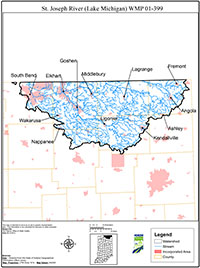Summary
In the fall of 2002, the Friends of the St. Joe River, a nonprofit established in 1994 by Athens, Mich. residents Al and Margaret Smith for the purpose of cleaning and restoring the river and its tributaries, was awarded a grant from the Michigan Department of Environmental Quality to develop a watershed management plan (WMP) for the entire St. Joseph River Watershed. This plan will unite stakeholders in a concerted effort to address water quality issues and natural resource protection across jurisdictional boundaries. Although several Lake Michigan Lake-wide Management Plan (LaMP), Lake and River Enhancement Program (LARE), and federally funded Clean Water Act (Sections 319 and 205j) projects have been conducted in subwatersheds in both Michigan and Indiana, and the St. Joseph River has been identified by USEPA as the biggest contributor of Atrazine to Lake Michigan and a significant contributor of sediments and toxic substances such as mercury and polychlorinated biphenyl (PCB), no comprehensive planning effort for the entire watershed has been conducted.
At this time, a number of areas have been added to the 303(d) lists (lists of water bodies that do not meet minimum water quality standards) in Michigan and Indiana and Total Maximum Daily Load (TMDL) parameters are scheduled to be developed to address impairments, but only two have an approved TMDL – adjoining sections approximately 32 miles long from the Lake Michigan confluence upstream to the Michigan/Indiana state line south of Niles. These TMDLs address pathogen problems due to combined sewer overflows (CSOs), stormwater discharges, and agricultural inputs. The other impaired waters in the basin have TMDLs scheduled to be developed in 2005 and beyond. The reasonable assurance activities identified in the completed TMDL for the St. Joseph River mentioned above are incorporated into this WMP. Furthermore, many of the strategies and best management practices (BMPs) identified in this WMP will make significant impacts on the quality of impaired waters on the 303(d) lists and can be utilized, along with input from agencies and individuals involved in this planning project, in the development of future TMDLs.
The Friends of the St. Joe River, the lead agency, coordinated with other key organizations for watershed plan preparation. This included oversight of the development process for the plan, as well as associated information/education activities, community involvement, and public participation. Kieser and Associates of Kalamazoo, Mich. provided technical services and Web site design and programming for the project. Christina Bauer served as the Michigan Department of Environmental Quality (MDEQ) representative. Nathan Rice served as the Indiana Department of Environmental Management (IDEM) representative. Both provided valuable oversight, assistance, and advice to the Steering Committee, technical consultants, and Watershed Coordinator.
The WMP was developed from November 2002 through June 2005. During the planning phase, technical data on the watershed (i.e. land use, subwatershed boundaries, population, soil types, topography, pesticide use, geological features, flora and fauna) was collected and analyzed in order to identify and prioritize pollutants (their sources and impacts), critical areas for preservation and mitigation, and the BMPs that can most effectively achieve the goals determined by the Steering Committee. These data were collected from a variety of sources, such as 303(d) and 305(d) lists, nonpoint source models, subwatershed plans, United States Geological Services (USGS) water quality sampling stations, stakeholder interviews, the Natural Resources Conservation Service (NRCS), the Michigan Center for Geographic Information, and the Lake Michigan Mass Balance Study. A technical support team assisted the technical consultants with this process.
All interested stakeholders were encouraged to become part of the WMP development process. An information and education program was planned and conducted by the Watershed Coordinator in close consultation with the Information and Education Subcommittee and involved newsletters, press releases, newspaper articles, a brochure, public meetings, and educational workshops. The Watershed Coordinator also participated in several training programs. In order to identify issues of concern among residents in the watershed, a series of public meetings and educational workshops were held throughout the watershed. Both the public meetings and the educational workshops introduced the watershed project and provided residents with a forum to express their concerns or ask questions.

